Sir John Monash, Personal Files Book 2, 23 February - 31 March 1915, Part 8
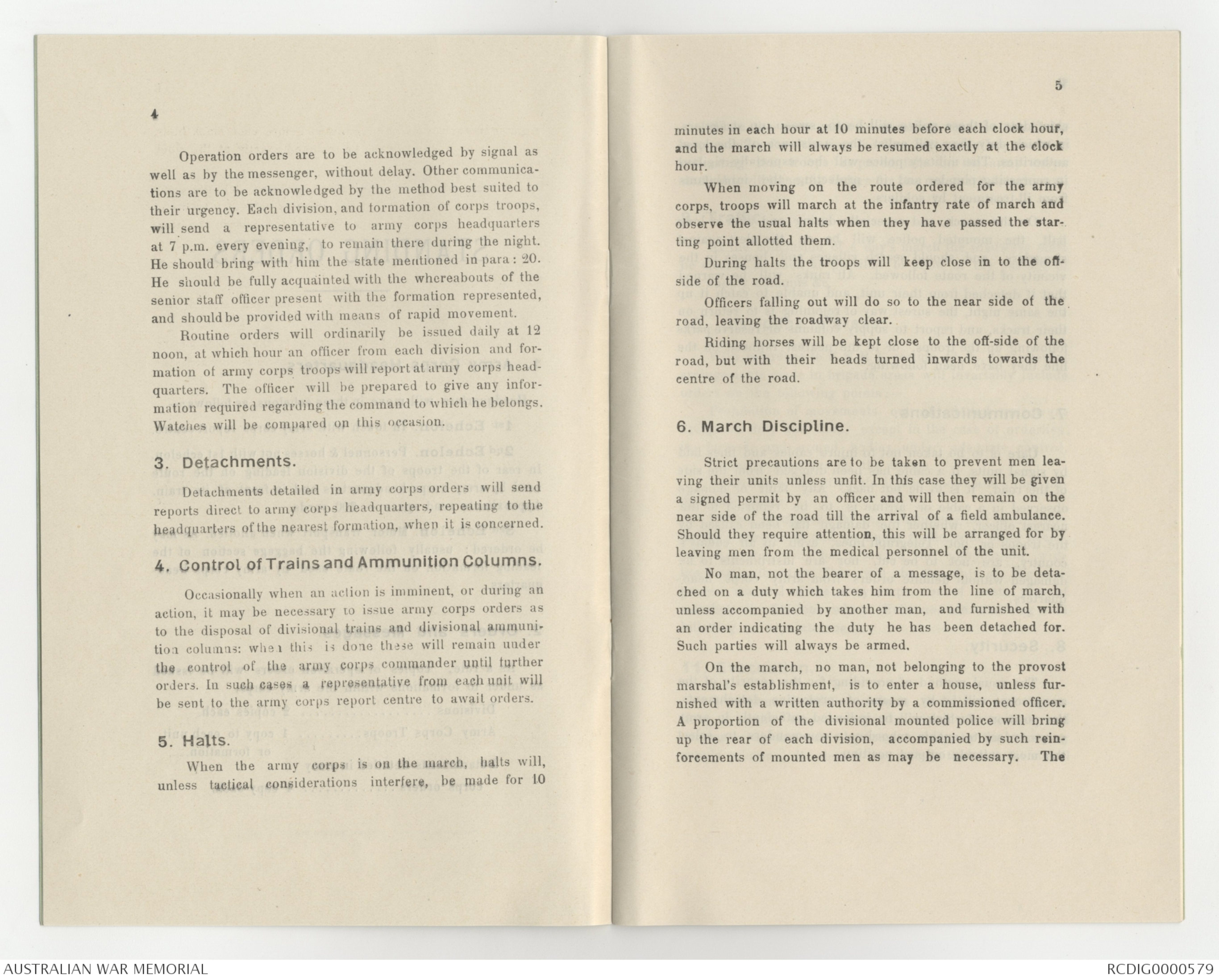
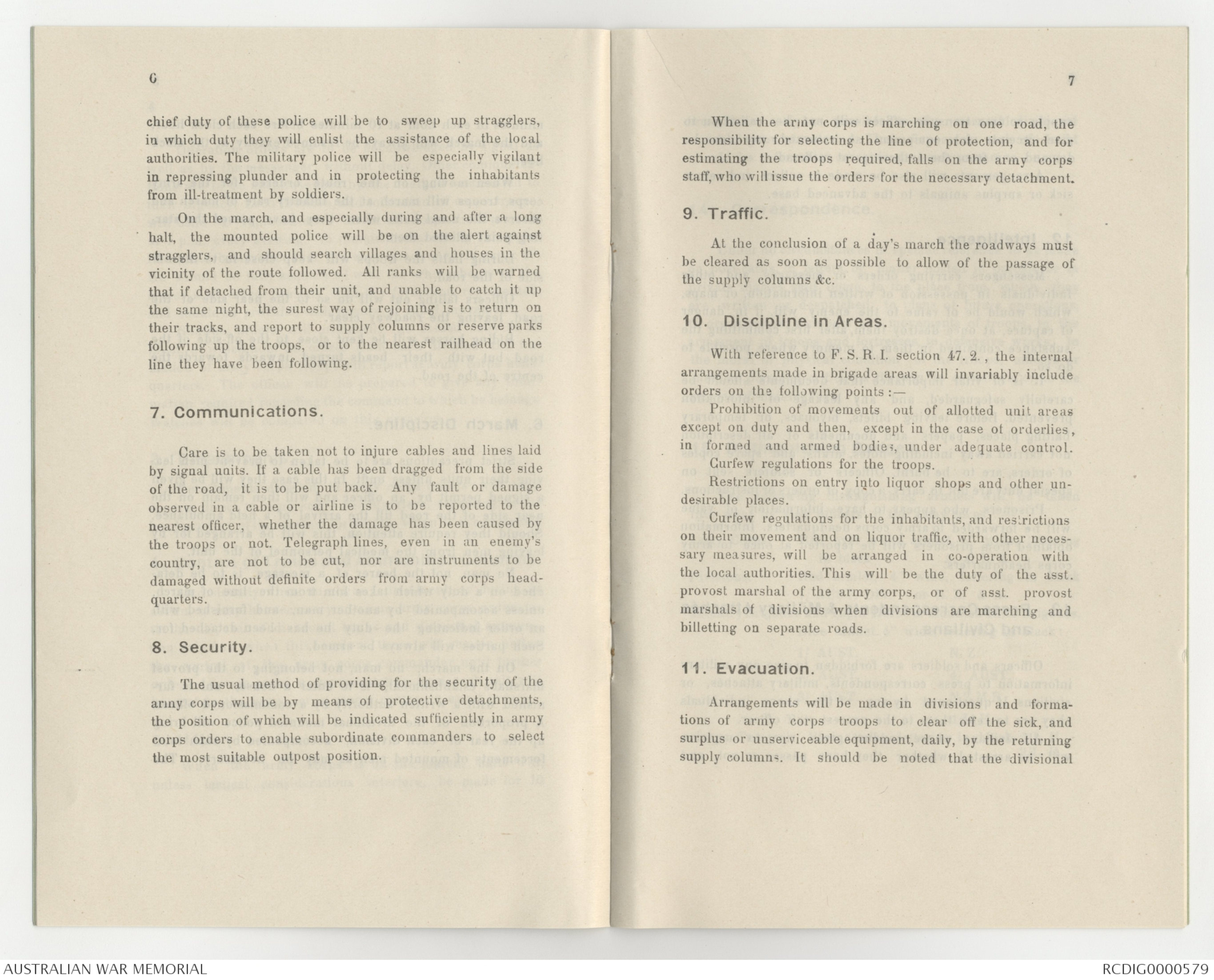
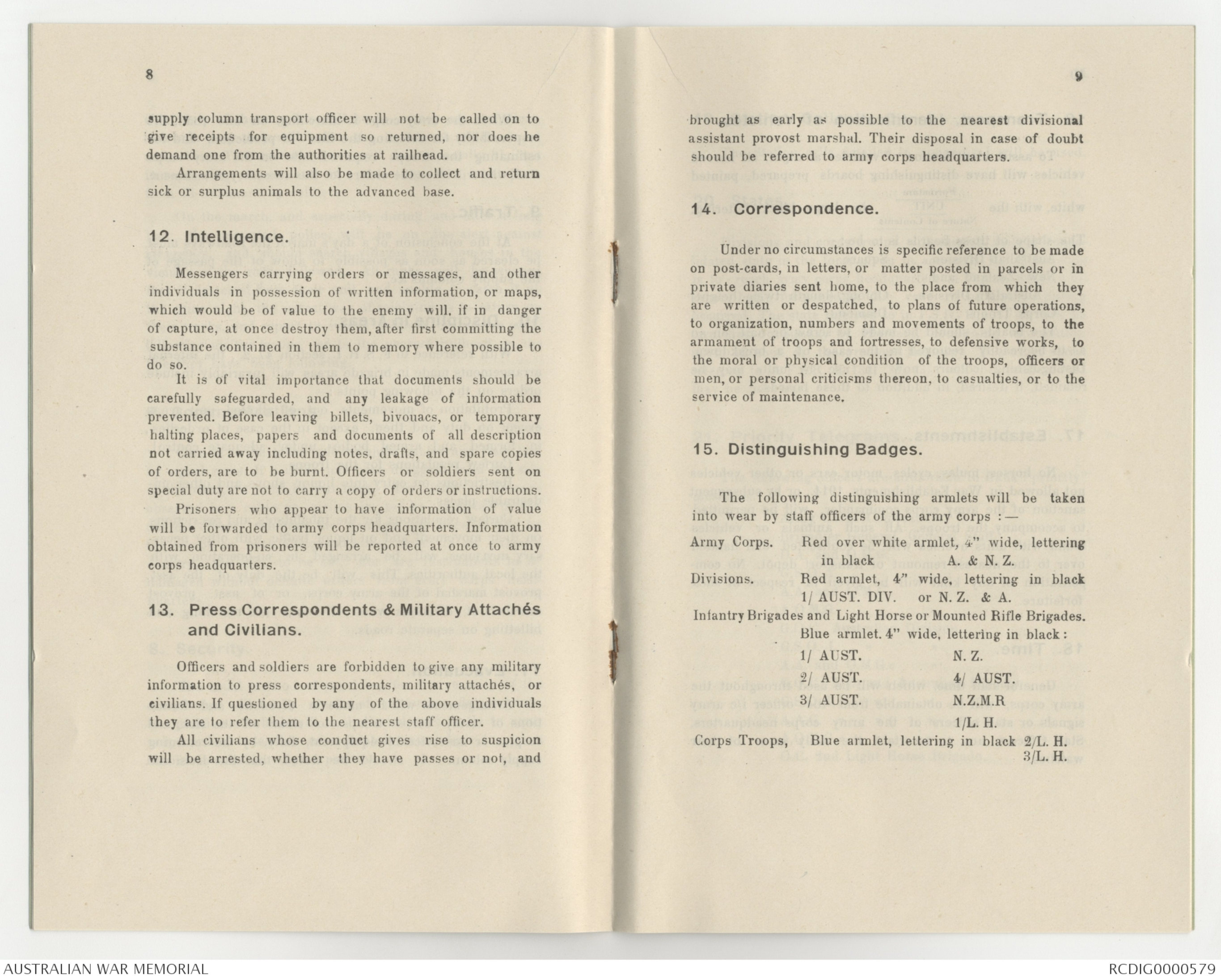
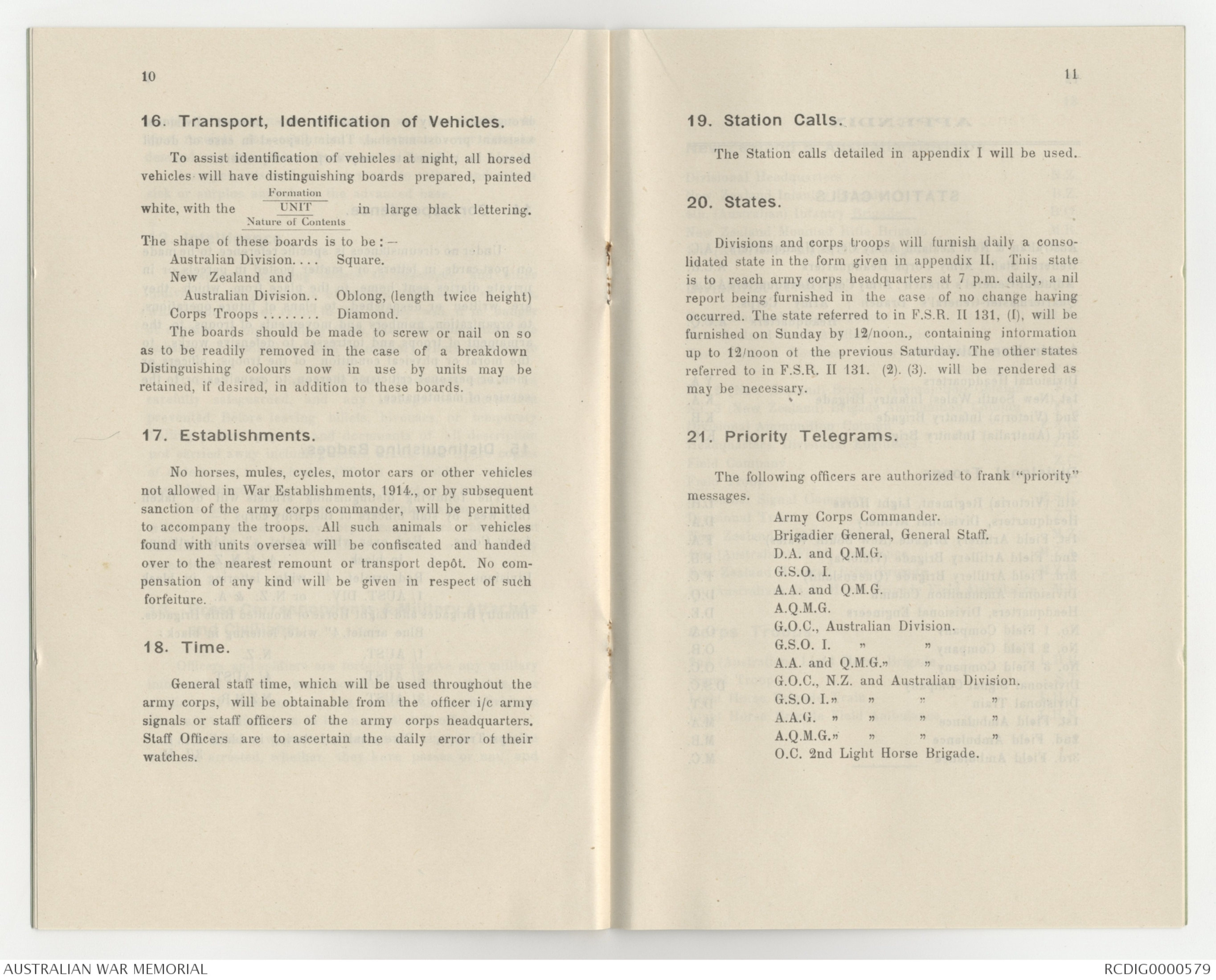
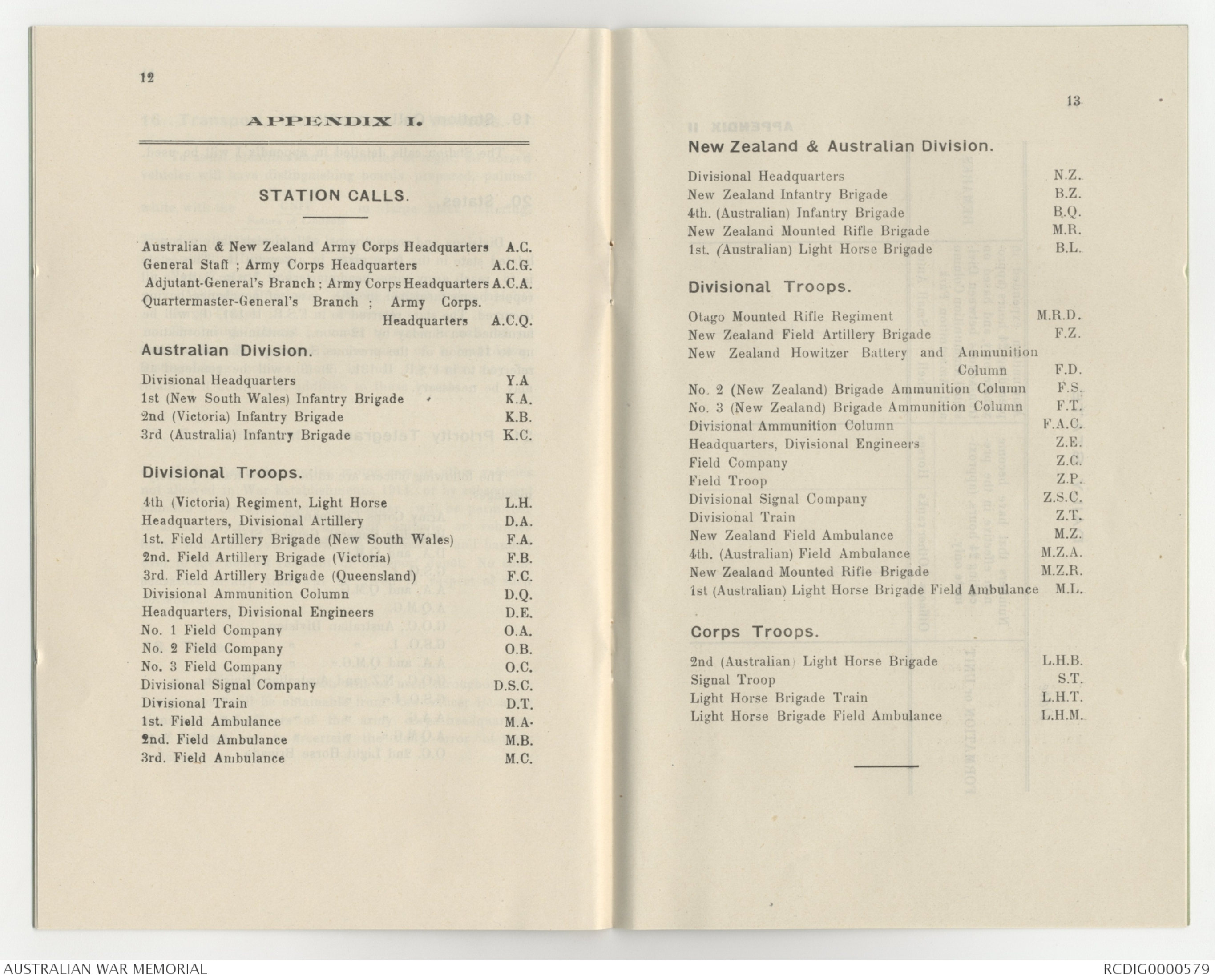
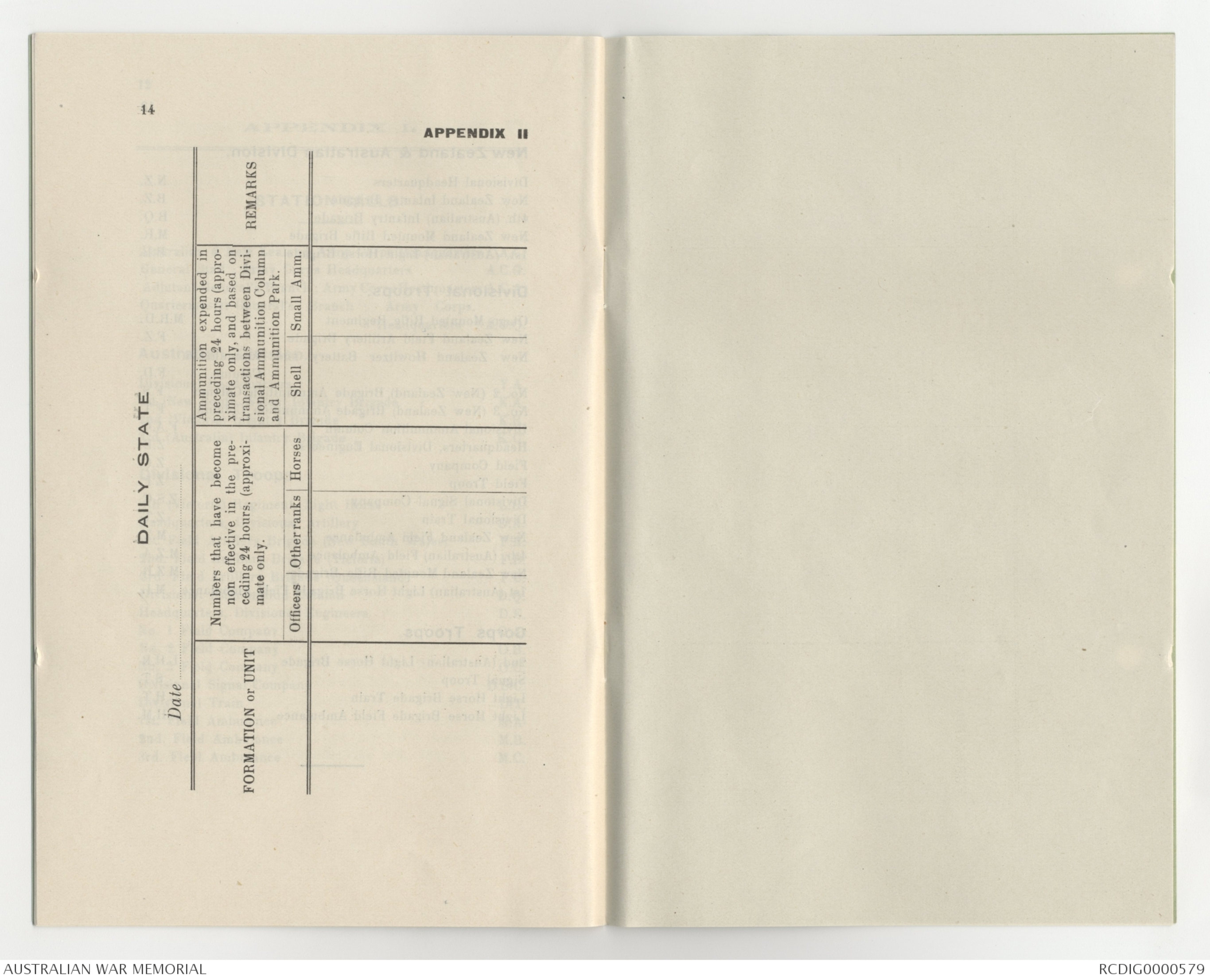
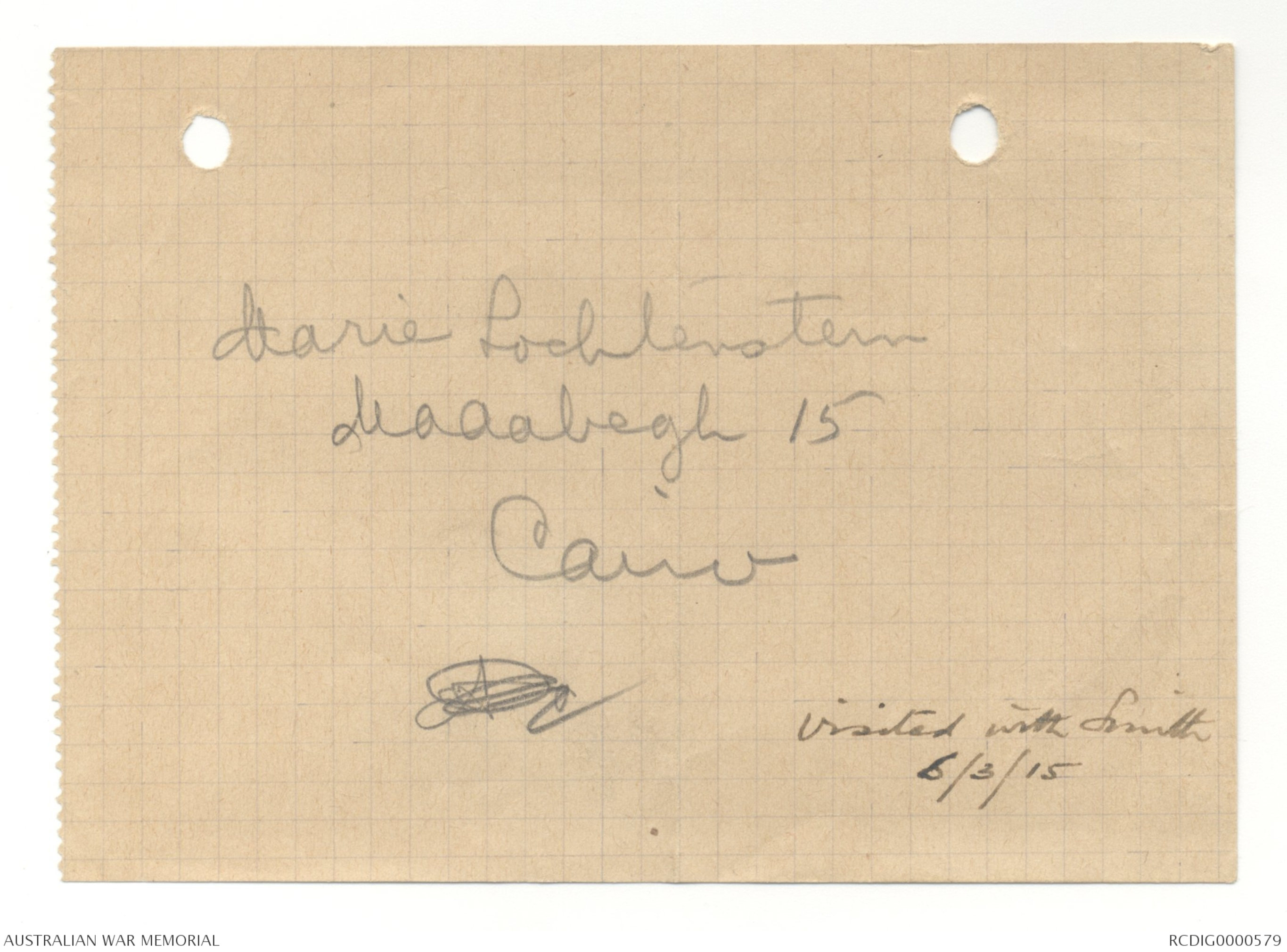
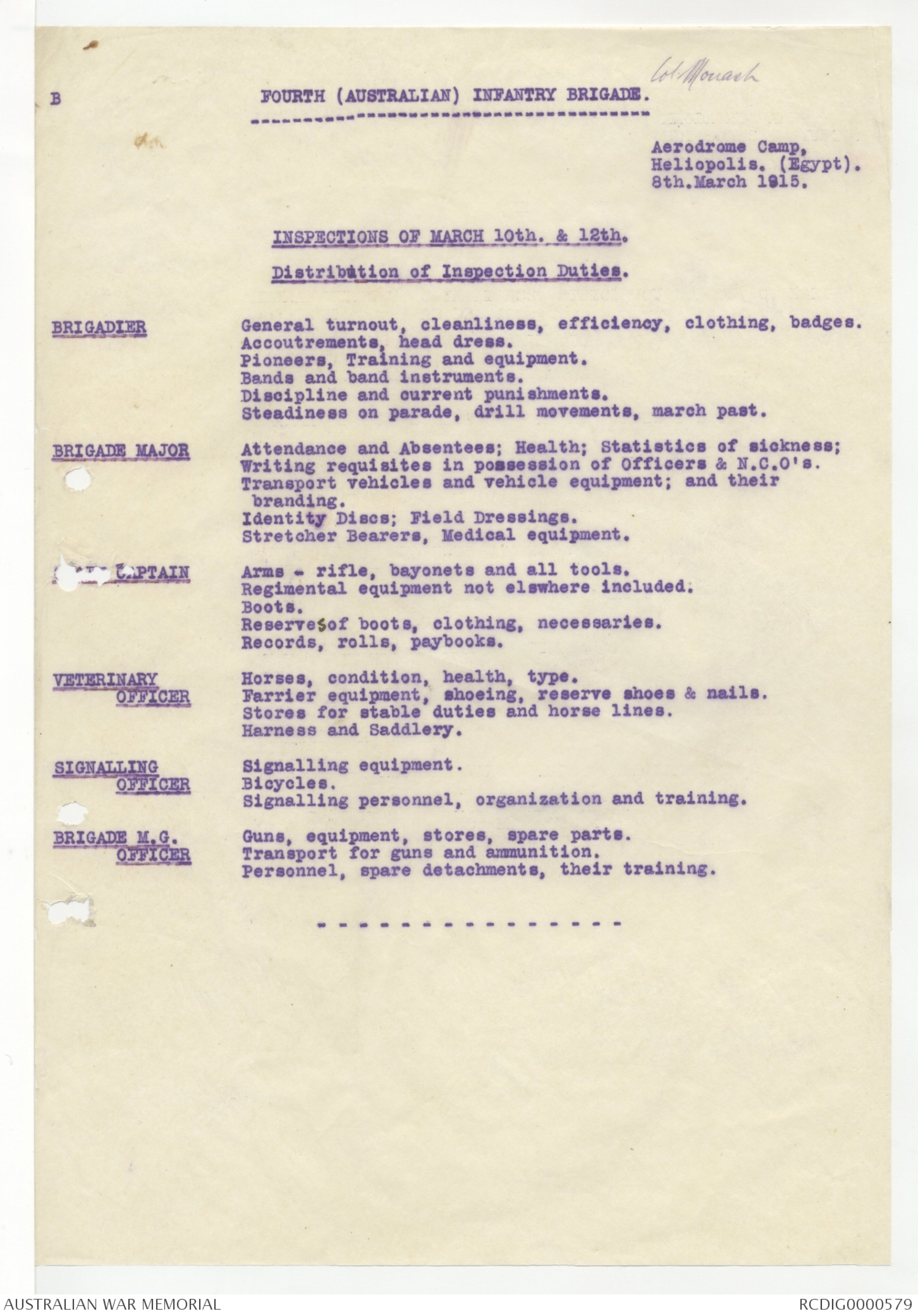
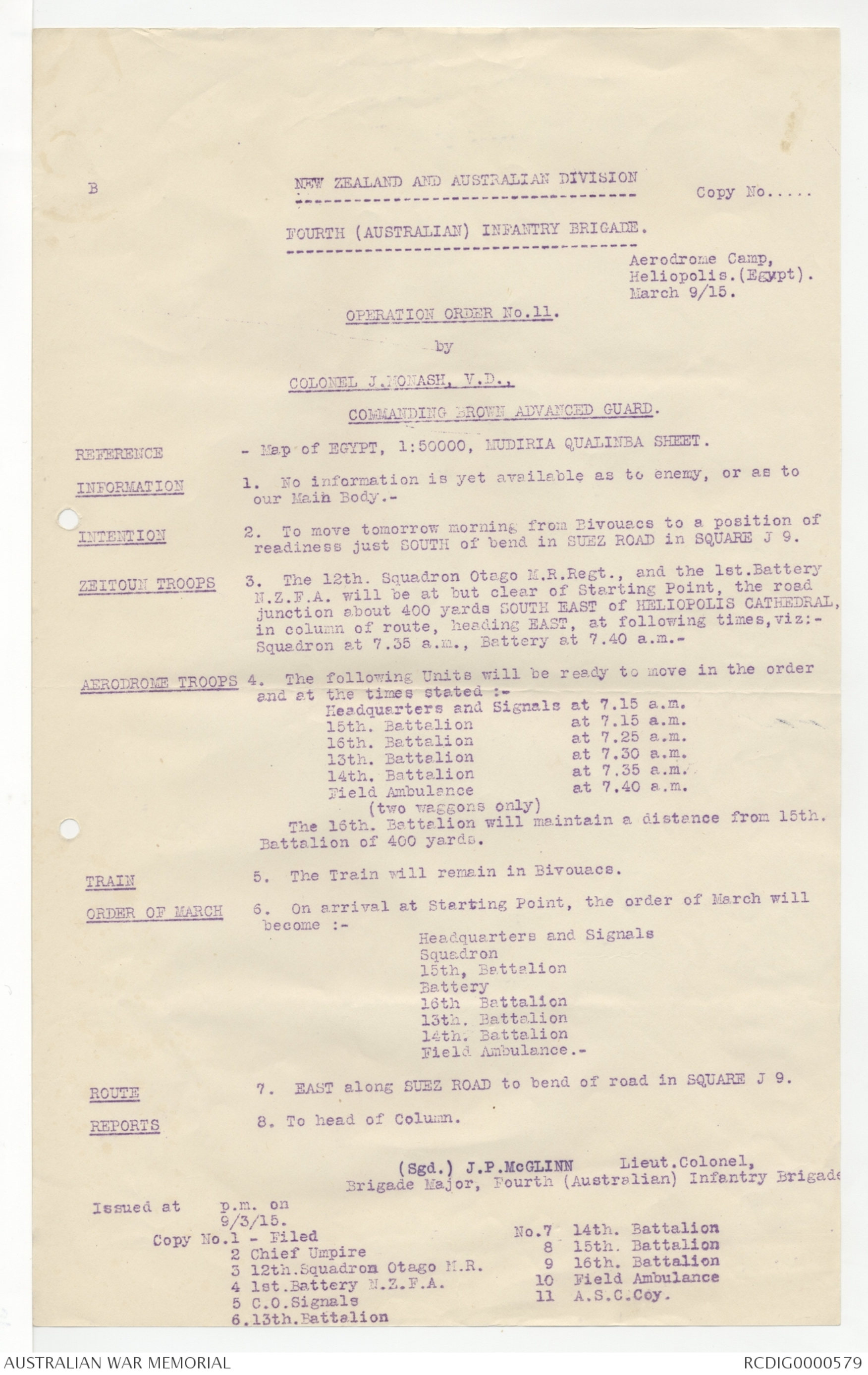
4/
Operation orders are to be acknowledged by signal as
well as by the messenger, without delay. Other communications
are to be acknowledged by the method best suited to
their urgency. Each division, and formation of corps troops,
will send a representative to army corps headquarters
at 7 p.m. every evening, to remain there during the night.
He should bring with him the state mentioned in para: 20.
He should be fully acquainted with the whereabouts of the
senior staff officer present with the formation represented,
and should be provided with means of rapid movement.
Routine orders will ordinarily be issued daily at 12
noon, at which hour an officer from each division and formation
of army corps troops will report at army corps headquarters.
The officer will be prepared to give any information
required regarding the command to which he belongs.
Watches will be compared on this occasion.
3. Detachments.
Detachments detailed in army corps orders will send
reports direct to army corps headquarters, repeating to the
headquarters of the nearest formation, when it is concerned.
4. Control of Trains and Ammunition Columns.
Occasionally when an action is imminent, or during an
action, it may be necessary to issue army corps orders as
to the disposal of divisional trains and divisional ammunition
columns: when this is done these will remain under
the control of the army corps commander until further
orders. In such cases a representative from each unit will
be sent to the army corps report centre to await orders.
5. Halts.
When the army corps is on the march, halts will,
unless tactical considerations interfere, be made for 10
5/
minutes in each hour at 10 minutes before each clock hour,
and the march will always be resumed exactly at the clock
hour.
When moving on the route ordered for the army
corps, troops will march at the infantry rate of march and
observe the usual halts when they have passed the starting
point allotted them.
During halts the troops will keep close in to the off-side
of the road.
Officers falling out will do so to the near side of the
road, leaving the roadway clear.
Riding horses will be kept close to the off-side of the
road, but with their heads turned inwards towards the
centre of the road.
6. March Discipline.
Strict precautions are to be taken to prevent men leaving
their units unless unfit. In this case they will be given
a signed permit by an officer and will then remain on the
near side of the road till the arrival of a field ambulance.
Should they require attention, this will be arranged for by
leaving men from the medical personnel of the unit.
No man, not the bearer of a message, is to be detached
on a duty which takes him from the line of march,
unless accompanied by another man, and furnished with
an order indicating the duty he has been detached for.
Such parties will always be armed.
On the march, no man, not belonging to the provost
marshal's establishment, is to enter a house, unless
furnished with a written authority by a commissioned officer.
A proportion of the divisional mounted police will bring
up the rear of each division, accompanied by such
reinforcements of mounted men as may be necessary. The
6/
chief duty of these police will be to sweep up stragglers,
in which duty they will enlist the assistance of the local
authorities. The military police will be especially vigilant
in repressing plunder and in protecting the inhabitants
from ill-treatment by soldiers.
On the march, and especially during and after a long
halt, the mounted police will be on the alert against
stragglers, and should search villages and houses in the
vicinity of the route followed. All ranks will be warned
that if detached from their unit, and unable to catch it up
the same night, the surest way of rejoining is to return on
their tracks, and report to supply columns or reserve parks
following up the troops, or to the nearest railhead on the
line they have been following.
7. Communications.
Care is to be taken not to injure cables and lines laid
by signal units. If a cable has been dragged from the side
of the road, it is to be put back. Any fault or damage
observed in a cable or airline is to be reported to the
nearest officer, whether the damage has been caused by
the troops or not. Telegraph lines, even in an enemy's
country, are not to be cut, nor are instruments to be
damaged without definite orders from army corps head-
quarters.
8. Security.
The usual method of providing for the security of the
army corps will be by means of protective detachments,
the position of which will be indicated sufficiently in army
corps orders to enable subordinate commanders to select
the most suitable outpost position.
7/
When the army corps is marching on one road, the
responsibility for selecting the line of protection, and for
estimating the troops required, falls on the army corps
staff, who will issue the orders for the necessary detachment.
9. Traffic.
At the conclusion of a days march the roadways must
be cleared as soon as possible to allow of the passage of
the supply columns &c.
10. Discipline in Areas.
With reference to F.S.R.L section 47.2., the internal
arrangements made in brigade areas will invariably include
orders on the following points:—
Prohibition of movements out of allotted unit areas
except on duty and then, except in the case of orderlies,
in formed and armed bodies; under adequate control.
Curfew regulations for the troops.
Restrictions on entry into liquor shops and other
undesirable places.
Curfew regulations for the inhabitants, and restrictions
on their movement and on liquor traffic, with other
necessary measures, will be arranged in co-operaton with
the local authorities. This will be the duty of the asst.
provost marshal of the army corps, or of asst. provost
marshals of divisions when divisions are marching and
billetting on separate roads.
11. Evacuation.
Arrangements will be made in divisions and formations
of army corps troops to clear off the sick, and
surplus or unserviceable equipment, daily, by the returning
supply columns. It should be noted that the divisional
8/
supply column transport officer will not be called on to
give receipts for equipment so returned, nor does he
demand one from the authorities at railhead.
Arrangements will also be made to collect and return
sick or surplus animals to the advanced base.
12. Intelligence.
Messengers carrying orders or messages, and other
individuals in possession of written information, or maps,
which would be of value to the enemy will, if in danger
of capture, at once destroy them, after first committing the
substance contained in them to memory where possible to
do so.
It is of vital importance that documents should be
carefully safeguarded, and any leakage of information
prevented. Before leaving billets, bivouacs, or temporary
halting places, papers and documents of all description
not carried away including notes, drafts, and spare copies
of orders, are to be burnt. Officers or soldiers sent on
special duty are not to carry a copy of orders or instructions.
Prisoners who appear to have information of value
will be forwarded to army corps headquarters. Information
obtained from prisoners will be reported at once to army
corps headquarters.
13. Press Correspondents & Military Attachés
and Civilians.
Officers and soldiers are forbidden to give any military
information to press correspondents, military attachés, or
civilians. If questioned by any of the above individuals
they are to refer them to the nearest staff officer.
All civilians whose conduct gives rise to suspicion
will be arrested, whether they have passes or not and
9/
brought as early as possible to the nearest divisional
assistant provost marshal. Their disposal in case of doubt
should be referred to army corps headquarters.
14. Correspondence.
Under no circumstances is specific reference to be made
on post-cards, in letters, or matter posted in parcels or in
private diaries sent home, to the place from which they
are written or despatched, to plans of future operations,
to organization, numbers and movements of troops, to the
armament of troops and fortresses, to defensive works, to
the moral or physical condition of the troops, officers or
men, or personal criticisms thereon, to casualties, or to the
service of maintenance.
15. Distinguishing Badges.
The following distinguishing armlets will be taken
into wear by staff officers of the army corps:-
Army Corps. Red over white armlet, 4” wide, lettering
in black A. & N. Z.
Divisions. Red armlet, 4” wide, lettering in black
1/AUST. DIV. or N.Z. & A.
Infantry Brigades and Light Horse or Mounted Rifle Brigades.
Blue armlet. 4" wide, lettering in black:
1/ AUST. N. Z.
2/ AUST 4/ AUST.
3) AUST. NZMR
1/IL. H.
Corps Troops, Blue armlet, lettering in black
2/L. H.
3 L. H.
10/
16. Transport, Identification of Vehicles.
To assist identification of vehicles at night, all horsed
vehicles will have distinguishing boards prepared, painted
Formation
white, with the UNIT in large black lettering.
Nature of Contents
The shape of these boards is to be:-
Australian Division.. Square.
New Zealand and
Australian Division.. Oblong, (length twice height)
Corps Troops........ Diamond.
The boards should be made to screw or nail on. so
as to be readily removed in the case of a breakdown
Distinguishing colours now in use by units may be
retained, if desired, in addition to these boards.
17. Establishments.
No horses, mules, cycles, motor cars or other vehicles
not allowed in War Establishments, 1914., or by subsequent
sanction of the army corps commander, will be permitted
to accompany the troops. All such animals or vehicles
found with units oversea will be confiscated and handed
over to the nearest remount or transport depot. No
compensation of any kind will be given in respect of such
forfeiture.
18. Time.
General staff time, which will be used throughout the
army corps, will be obtainable from the officer i/c army
signals or staff officers of the army corps headquarters.
Staff Officers are to ascertain the daily error of their
watches.
11/
19. Station Calls.
The Station calls detailed in appendix I will be used.
20. States.
Divisions and corps troops will furnish daily a consolidated
state in the form given in appendix II. This state
is to reach army corps headquarters at 7 p.m. daily, a nil
report being furnished in the case of no change having
occurred. The state referred to in F.S.R. II 131, (I), will be
furnished on Sunday by 12/noon., containing information
up to 12/noon of the previous Saturday. The other states
referred to in F.S.R. II 131. (2). (3). will be rendered as
may be necessary.
21. Priority Telegrams.
The following officers are authorized to frank "priority"
messages.
Army Corps Commander.
Brigadier General, General Staff.
D.A. and Q.M.G.
G.S.O. I
A.A and Q.M.G.
A.Q.M.G.
G.O.C, Australian Division.
G.S.O. I " "
A.A and Q.MG.. " "
G.O.C. NZ. and Australian Division.
G.S.O. I " " " "
A.AG. " . " " "
A.Q.M.G." " " "
O.C. 2nd Light Horse Brigade.
12/
APPENDIX 1.
STATION CALLS.
Australian New Zealand Army Corps Headquarters A.C.
General Staff; Army Corps Headquarters A.C.G.
Adjutant-General's Branch; Army Corps Headquarters A.C.A.
Quartermaster-General's Branch; Army Corps.
Headquarters A.C.Q.
Australian Division.
Divisional Headquarters Y.A.
1st (New South Wales) Infantry Brigade. K.A.
2nd (Victoria) Infantry Brigade. K.B.
3rd (Australia) Infantry Brigade. K.C.
Divisional Troops.
4th (Victoria) Regiment, Light Horse. L.H.
Headquarters, Divisional Artillery. D.A.
.1st Field Artillery Brigade (New South Wales) F.A.
2nd. Field Artillery Brigade (Victoria) F.B.
3rd. Field Artillery Brigade (Queensland). F.C.
Divisional Ammunition Column. D.O.
Headquarters, Divisional Engineers. D.E.
No. 1 Field Company O.A.
No. 2 Field Company O.B.
No. 3 Field Company O.C.
Divisional Signal Company D.S.C.
Divisional Train. D.T.
1st. Field Ambulance M.A.
2nd. Field Ambulance. M.B.
3rd. Field Ambulance M.C.
13/
New Zealand & Australian Division.
Divisional Headquarters N.Z.
New Zealand Infantry Brigade B.Z.
4th. (Australian) Infantry Brigade B.Q.
New Zealand Mounted Rifle Brigade
1st (Australian) Light Horse Brigade B.L.
Divisional Troops.
Otago Mounted Rifle Regiment M.R.D.
New Zealand Field Artillery Brigade F.Z.
New Zealand Howitzer Battery and Ammunition
Column F.D.
No. 2 (New Zealand) Brigade Ammunition Column F.S.
No. 3 (New Zealand) Brigade Ammunition Column F.T.
Divisional Ammunition Column F.A.C.
Headquarters, Divisional Engineers Z.E.
Field Company Z.C.
Field Troop Z.P.
Divisional Signal Company Z.S.C.
Divisional Train Z.T.
New Zealand Field Ambulance M.Z.
4th. (Australian) Field Ambulance M.Z.A.
New Zealand Mounted Rifle Brigade M.Z.R.
1st (Australian) Light Horse Brigade Field Ambulance M.L.
Corps Troops.
2nd (Australian) Light Horse Brigade L.H.B.
Signal Troop S.T.
Light Horse Brigade Train L.H.T.
Light Horse Brigade Field Ambulance L.H.M.
14
DAILY STATE
Date
FORMATION of UNIT
Numbers that have become non effective in the preceding 24 hours (approximate only.
Officers Other ranks Horses
Ammunition expended in preceding 24 hours (approximate only, and based on transactions between Divisional Ammunition Column and Ammunition Park
Shell Small Amm.
REMARKS
Marie Lochlenotern
Madabegh 15
Cairo
visited with Smith
6/3/15
Col. Monash
FOURTH (AUSTRALIAN) INFANTRY BRIGADE.
Aerodrome Camp
Heliopolis. (Egypt).
8th. March 1915.
INSPECTIONS OF MARCH 10th. & 12th.
Distribution of Inspection Duties.
BRIGADIER General turnout, cleanliness, efficiency, clothing, badges.
Accoutrements, head dress.
Pioneers, Training and equipment.
Bands and band instruments.
Discipline and current punishments.
Steadiness on parade, drill movements, march past.
BRIGADE MAJOR Attendance and Absentees; Health; Statistics of sickness;
Writing requisites in possession of Officers & N.C.O's.
Transport vehicles and vehicle equipment; and their
branding.
Identity Discs; Field Dressings.
Stretcher Bearers, Medical equipment.
CAPTAIN Arms- rifle, bayonets and all tools.
Regimental equipment not elswhere included:
Boots.
Reserves of boots, clothing, necessaries.
Records, rolls, paybooks.
VETERINARY OFFICER Horses, condition, health, type.
Farrier equipment, shoeing, reserve shoes a nails.
Stores for stable duties and horse lines.
Harness and Saddlery.
SIGNALLING OFFICER Signalling equipment.
Bicycles.
Signalling personnel, organization and training.
BRIGADE M.G. OFFICER Guns, equipment, stores, spare parts.
Transport for guns and ammunition.
Personnel, spare detachments, their training.
NEW ZEALAND AND AUSTRALIAN DIVISION
Copy No.....
FOURTH (AUSTRALIAN) INFANTRY BRIGADE.
Aerodrome Camp,
Heliopolis. (Egypt).
March 9/15.
OPERATION ORDER NO. 11.
by
COLONEL J. MONASH, V.D.,
COMMANDING BROWN ADVANCED GUARD.
REFERENCE
- Map of EGYPT, 1:50000, MUDIRIA QUALINBA SHEET.
INFORMATION
1. No information is yet available as to enemy, or as to
our Main Body.-
INTENTION
2. To move tomorrow morning from Bivouacs to a position
of readiness just SOUTH of bend in SUEZ ROAD in SQUARE J 9
ZEITOUN TROOPS
3. The 12th. Squadron Otago M.R.Regt., and the lst.Battery
N.Z.F.A will be at but clear of Starting Point, the road
junction about 400 yards SOUTH EAST of HELIOPOLIS CATHEDRAL,
in column of route, heading EAST, at following times,viz:-
Squadron at 7.35 a.m., Battery at 7.40 a.m.-
AERODROME TROOPS
4. The following Units will be ready to move in the order
and at the times stated :-
Headquarters and Signals at 7.15 a.m.
15th. Battalion at 7.15 am
16th. Battalion at 7.25am
13th. Battalion at 7.30 am
14th. Battalion at 7.35 am
Field Ambulance at 7.40am
(two waggons only)
The l6th. Battalion will maintain a distance from 15th. Battalion of 400 yards.
TRAIN
5. The Train will remain in Bivouacs.
ORDER OF MARCH
6. On arrival at Starting Point, the order of March will become :-
Headquarters and Signals
Squadron
15th, Battalion
Battery
16th Battalion
13th. Battalion
l4th. Battalion
Field Ambulance.-
ROUTE
7. EAST along SUEZ ROAD to bend of road in SQUARE J 9.
REPORTS
8. To head of Column.
(sgd.) J.P.McGLINN Lieut.Colonel
Brigade Major, Fourth (Australian) Infantry Brigade
Issued at p.m. on
9/3/15.
Copy No.1 - Filed. No.7 14th Battalion
2 Chief Umpire. 8. 15th Battalion
3 12th.Squadron Otago M.R. 9 16th Battalion
4 lst.Battery N.Z.F.A. 10 Field Ambulance
5 C.O.Signals. 11 A.S.C. Coy
6.13th. Battalion
 Jacqueline Kennedy
Jacqueline KennedyThis transcription item is now locked to you for editing. To release the lock either Save your changes or Cancel.
This lock will be automatically released after 60 minutes of inactivity.